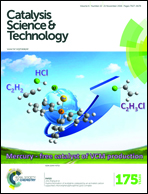Molybdenum phosphide as a novel and stable catalyst for dry reforming of methane†
Abstract
In this work, we proposed a novel catalyst, molybdenum phosphide (MoP), which exhibited high coking and oxidation resistance for dry reforming of CH4 with CO2 (DRM). The catalytic stability of MoP was found to be superior to that of Ni/Mo2C (recently known to be an efficient non-noble metal catalyst for DRM). At higher temperatures (≥800 °C) and weight hourly space velocity (WHSV) values, the MoP catalyst would deactivate due to the oxidation of the catalyst to MoO2 with the loss of P, while operation at a lower temperature (750 °C) and WHSV resulted in stabilization of the MoP for the duration of the experiments (100 h). This might be due to a decrease in the oxidant-to-catalyst exposure. It was proposed that there were two possible DRM mechanisms (redox-type and noble metal-type) over the MoP catalyst, which were similar to those over the Ni/Mo2C catalyst. Nevertheless, the contribution of the noble metal-type mechanism to DRM activity on MoP was more than that on Ni/Mo2C, which accounted for the fact that the former showed better stability than the latter. It was suggested that the noble metal-type mechanism should be preferable for DRM over carbide and phosphide catalysts.


 Please wait while we load your content...
Please wait while we load your content...